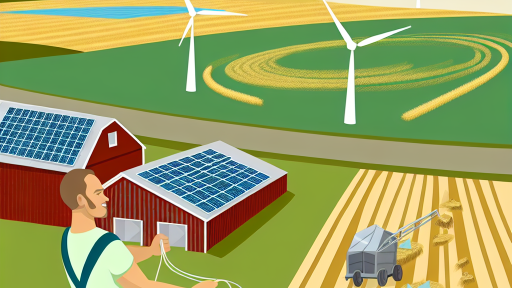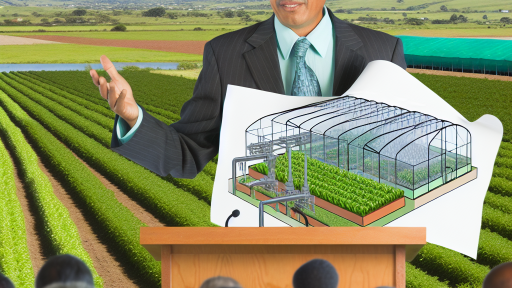Introduction to Conservation Programs and Their Importance
Conservation programs play a vital role in sustainable farming practices.
They support the health of ecosystems while ensuring agricultural productivity.
Farmers benefit from these programs by enhancing soil quality and preserving water resources.
Moreover, these initiatives improve crop resilience against climate change.
Understanding Conservation Programs
Conservation programs often include practices like crop rotation and cover cropping.
These methods reduce soil erosion and improve soil fertility.
Farmers can also receive financial incentives to adopt these practices.
Consequently, they experience reduced costs in the long run.
The Role of Government and Organizations
Government bodies and environmental organizations promote conservation programs.
They provide guidelines and support to implement effective practices.
Additionally, they help farmers access funding for sustainable initiatives.
This collaboration fosters a community dedicated to preserving natural resources.
Long-Term Benefits for Farmers
Farmers participating in conservation programs enjoy numerous advantages.
Increased biodiversity leads to healthier ecosystems on farms.
This translates into better crop yields and pest management.
Transform Your Agribusiness
Unlock your farm's potential with expert advice tailored to your needs. Get actionable steps that drive real results.
Get StartedFarmers also benefit from enhanced market opportunities due to sustainable labels.
Environmental Impacts
Conservation programs significantly aid in reducing greenhouse gas emissions.
They promote better water management practices, which is crucial for drought mitigation.
Furthermore, these programs help protect endangered species and their habitats.
By preserving natural resources, farmers contribute to ecological balance.
Economic Benefits
Increased Crop Yields
Conservation programs significantly enhance crop yields for farmers.
These initiatives promote sustainable farming practices.
They help maintain soil health and fertility over time.
Farmers benefit from improved pest management strategies.
As a result, crops become more resilient to adverse conditions.
Environmental stewardship practices lead to higher productivity.
Moreover, diverse planting techniques boost overall harvest quality.
This combination ultimately increases the financial returns for farmers.
Reduced Input Costs
Implementing conservation programs can lower input costs dramatically.
Farmers often save money on fertilizers and pesticides.
Natural methods of pest control reduce reliance on chemicals.
Additionally, improved soil health minimizes the need for synthetic inputs.
Water conservation practices help reduce irrigation costs.
Consequently, farmers can allocate saved resources elsewhere.
This efficiency contributes to a more sustainable farming approach.
Ultimately, lower input costs enhance overall farm profitability.
Environmental Advantages
Soil Health
Conservation programs significantly improve soil health.
They promote better soil structure and composition.
Healthy soil retains moisture more effectively.
Showcase Your Farming Business
Publish your professional farming services profile on our blog for a one-time fee of $200 and reach a dedicated audience of farmers and agribusiness owners.
Publish Your ProfileAs a result, farmers save money on irrigation.
Additionally, these programs reduce soil erosion.
This enables farmers to maintain their land’s productivity.
Moreover, enriched soil fosters robust plant growth.
Consequently, crop yields often increase over time.
Biodiversity Preservation
Conservation initiatives enhance biodiversity on farms.
They provide habitats for various species.
A diverse ecosystem contributes to natural pest control.
Additionally, it helps in pollination processes.
Such ecological balance is beneficial to agriculture.
Furthermore, healthy ecosystems reduce dependency on chemicals.
Farmers can thus adopt organic farming practices more easily.
As a result, the overall health of the environment improves.
Discover More: Key Food Safety Regulations Every Farmer Should Know
Water Conservation Strategies and Their Long-Term Impact
Importance of Water Conservation
Water conservation plays a vital role in sustainable farming practices.
It helps farmers manage their water resources more efficiently.
Proper strategies reduce dependency on external water sources.
Moreover, conserving water improves soil health and crop yields.
Implementing Effective Water Conservation Techniques
Farmers can adopt various strategies to conserve water.
One effective method is rainwater harvesting.
This technique captures rainwater for irrigation purposes.
Additionally, using drip irrigation reduces water wastage significantly.
Benefits of Using Cover Crops
Cover crops enhance soil moisture retention.
They also prevent soil erosion and nutrient leaching.
Furthermore, cover crops improve soil structure over time.
Long-Term Economic Advantages
Investing in water conservation strategies yields long-term benefits.
Farmers can save money on water bills and irrigation costs.
Additionally, healthy crops lead to higher market prices.
Environmental Impact of Water Conservation
Water conservation practices benefit the environment significantly.
Reduced water usage lowers the strain on local water resources.
This approach helps maintain local ecosystems and wildlife habitats.
Conserving water also mitigates the effects of climate change.
The Role of Community in Water Conservation
Community involvement enhances the effectiveness of conservation programs.
Farmers can share knowledge and resources to create better outcomes.
Collaborative efforts can lead to more substantial impacts over time.
Learn More: Policy Strategies for Climate-Smart Agriculture
Government Incentives and Subsidies Supporting Conservation Efforts
Introduction to Government Support
Government programs play a critical role in promoting conservation among farmers.
These initiatives often include financial incentives that encourage sustainable practices.
Farmers can benefit significantly from these support systems.
Types of Financial Incentives
Various types of incentives exist to support conservation efforts.
Showcase Your Farming Business
Publish your professional farming services profile on our blog for a one-time fee of $200 and reach a dedicated audience of farmers and agribusiness owners.
Publish Your Profile- Direct payments reward farmers for implementing environmentally friendly practices.
- Tax credits can reduce financial burdens while promoting conservation methods.
- Cost-sharing programs help cover expenses for conservation projects.
Long-Term Financial Benefits
Investing in conservation programs leads to substantial long-term savings for farmers.
By adopting sustainable practices, farmers can improve soil health and reduce input costs.
These financial benefits often offset the initial investment in conservation practices.
Access to Specialized Resources
Government programs also provide access to valuable resources and expertise.
Farmers can receive guidance on best practices for conservation.
Additionally, they gain access to research and technology that enhances productivity.
Community and Environmental Impact
Engaging in conservation efforts positively impacts local communities and ecosystems.
Conservation can foster biodiversity and protect water resources in the region.
Moreover, these efforts often promote a healthier, more sustainable local economy.
Explore Available Government Incentives
Farmers are encouraged to explore available government incentives.
Taking advantage of these programs can lead to ecological and economic benefits.
Ultimately, investing in conservation is a win-win situation for both farmers and the environment.
Learn More: Complying with Animal Welfare Regulations: A Farmers Guide

Case Studies: Successful Implementation of Conservation Practices
Community-Driven Projects in Iowa
In Iowa, local farmers embraced cover cropping as a conservation practice.
This initiative improved soil health and reduced erosion.
Farmers reported increased organic matter in their soils.
Furthermore, they witnessed enhanced water retention.
The community-led approach fostered collaboration among farmers.
As a result, participants shared valuable insights and strategies.
Innovative Techniques in California
In California, ranchers implemented rotational grazing practices.
This method maximized land usage while promoting soil health.
By rotating livestock, the grasslands experienced rejuvenation.
Consequently, farmers observed increased forage production.
Additionally, this technique reduced methane emissions from livestock.
This innovative approach exemplifies sustainable grazing practices.
Partnerships in the Midwest
A partnership between university researchers and farmers in the Midwest focused on no-till farming.
This method minimizes soil disturbance in agricultural lands.
Farmers reported improved soil structure and biodiversity.
The collaboration allowed for shared research and development efforts.
In addition, it created a knowledge base on sustainable practices.
Farmers felt empowered to adopt new techniques confidently.
Restoration Efforts in the Great Plains
In the Great Plains, farmers engaged in habitat restoration for pollinators.
This initiative aimed to enhance local biodiversity and crop yields.
Farmers planted native wildflowers alongside crops.
This practice attracted beneficial insects, improving pollination rates.
Moreover, it increased resilience against pests and diseases.
The farmers saw a direct positive impact on their harvests.
Gain More Insights: Nutrient Management Standards for Farms
Resilience to Climate Change: Adapting Farming Practices
Understanding Climate-Resilient Practices
Farmers face increasing climate variability in their work.
Adapting farming practices promotes resilience against these changes.
Showcase Your Farming Business
Publish your professional farming services profile on our blog for a one-time fee of $200 and reach a dedicated audience of farmers and agribusiness owners.
Publish Your ProfileClimate-resilient practices enhance the long-term sustainability of agriculture.
Implementing Sustainable Techniques
Utilizing cover crops improves soil health.
These crops also help mitigate erosion and retain moisture.
Crop rotation aids in pest and disease management.
Furthermore, it reduces reliance on chemical inputs.
Conservation tillage protects the soil structure and biodiversity.
Utilizing Technology in Farming
Precision agriculture enhances resource use efficiency.
Farmers can monitor soil health and moisture levels accurately.
This technology enables timely interventions for crop care.
Ultimately, it leads to improved yields and reduced waste.
Community Collaboration and Education
Farmers benefit from sharing knowledge with peers.
Participating in workshops promotes the exchange of best practices.
Local agricultural extension programs offer valuable resources.
Collaboration fosters a community approach to climate resilience.
Long-Term Economic Benefits
Investing in conservation programs results in cost savings.
Improved soil health leads to higher quality crops.
This outcome increases market opportunities and profitability.
Moreover, farmers can qualify for subsidies and support programs.
Long-lasting resilience lowers the risk of crop failures.
Community Engagement and Education through Conservation Programs
The Role of Community Involvement
Community involvement is essential for successful conservation programs.
Farmers benefit greatly when local communities actively participate.
This engagement fosters a shared responsibility for natural resources.
Additionally, strong relationships build trust among stakeholders.
Educational Opportunities for Farmers
Conservation programs provide valuable educational resources to farmers.
Workshops and training sessions increase awareness of sustainable practices.
Farmers learn how to implement effective conservation techniques.
Furthermore, these programs offer insights into innovative technologies.
Collaboration with Local Organizations
Partnerships with local organizations enhance educational efforts.
These collaborations broaden the reach of conservation initiatives.
Local organizations often offer tailored support to meet specific needs.
For instance, they may provide resources on crop rotation and soil health.
Empowering Future Generations
Conservation programs also focus on educating youth about sustainability.
Engaging young people fosters a culture of environmental stewardship.
Schools and community groups can organize educational events.
Such initiatives instill a sense of responsibility in future farmers.
Evaluating the Impact of Community Engagement
Monitoring the results of community engagement is crucial.
Farmers can assess the effectiveness of educational programs.
Feedback helps improve future conservation initiatives.
Moreover, success stories inspire broader participation within the community.
Additional Resources
Conservation Reserve Program (CRP) | Farm Service Agency
Showcase Your Farming Business
Publish your professional farming services profile on our blog for a one-time fee of $200 and reach a dedicated audience of farmers and agribusiness owners.
Publish Your ProfilePreparing for the Next Farm Bill




